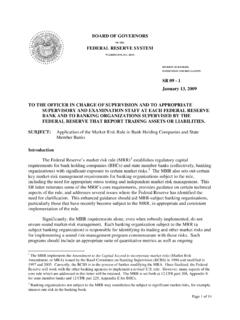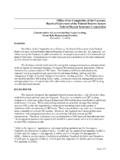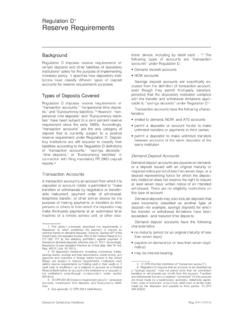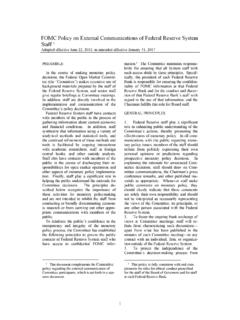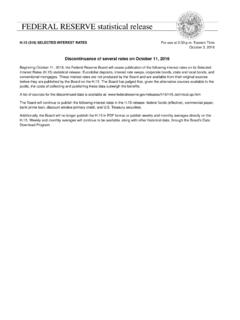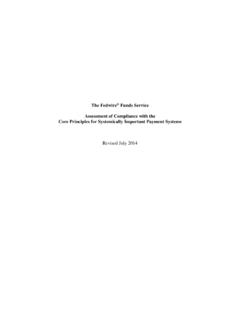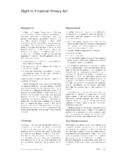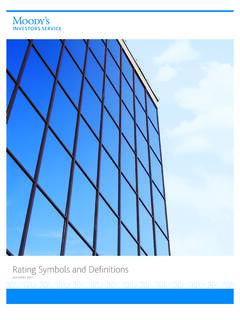Transcription of Report on the Federal Reserve’s Balance Sheet
1 Report on the Federal Reserve's Balance Sheet August 2020. BOARD OF GOVERNORS OF THE Federal RESERVE SYSTEM. Report on the Federal Reserve's Balance Sheet August 2020. BOARD OF GOVERNORS OF THE Federal RESERVE SYSTEM. This and other Federal Reserve Board reports and publications are available online at To order copies of Federal Reserve Board publications offered in print, see the Board's Publication Order Form ( ). or contact: Printing and Fulfillment Mail Stop K1-120. Board of Governors of the Federal Reserve System Washington, DC 20551. (ph) 202-452-3245. (fax) 202-728-5886. (email) Purpose The Federal Reserve prepares this Balance Sheet Report to help fulfill its commitment to trans- parency about actions taken in connection with two of its key functions conducting mon- etary policy to meet its congressional mandate and promoting financial stability. This Report provides an overview of the change in the size and composition of the Federal Reserve's Balance Sheet between March 11 and August 12, 2020, a period that reflects the forceful efforts the Federal Reserve has taken to support jobs and the broader economy dur- ing the disruptions caused by the COVID-19 pandemic.
2 In addition, it includes recent devel- opments and background information on the key line items on the Federal Reserve's Balance Sheet (including links to more detailed online information). The Balance Sheet and Its Role in the Federal Reserve's Key Functions The Federal Reserve is committed to transparency and accountability The Federal Reserve conducts monetary by providing the public and Congress policy in accordance with its mandate from detailed information about our Congress: to promote maximum employment actions to support the economy and stable prices in the economy. Finan- cial stability is an important prerequisite for during this difficult time.. achieving these goals. As a result, the Federal Reserve monitors financial stability risks and Chair Jerome H. Powell takes appropriate actions to help ensure that Federal Reserve Board of Governors financial institutions and financial markets are news release, April 23, 2020 (https://www able to efficiently channel the flow of credit to.)
3 Households, communities, and businesses. ). The Federal Reserve considers transparency about the goals, conduct, and stance of mon- etary policy to be fundamental to the effective- ness of monetary policy. Transparency about monetary policy also helps promote the accountability of the Federal Reserve to Congress and the public. The Federal Reserve's Response to COVID-19. Over the past several months, the United States and the world have faced unprecedented chal- lenges from the COVID-19 pandemic. It has taken a tragic and growing toll in illnesses and lost lives, forced many businesses to close, and thrown millions of people out of work. The effect on the economy has been severe, particularly in the second quarter, disrupting financial markets and impairing the flow of credit. Without access to credit, families can be forced to cut back on necessities and could lose their homes. Businesses can be forced to downsize or permanently close, resulting in further losses iii iv Report on the Federal Reserve's Balance Sheet of jobs and incomes and worsening the economic downturn.
4 Preserving the flow of credit and reducing borrowing costs is thus essential for mitigating the damage to the economy from the pandemic and setting the stage for the recovery. Beginning in March, the Federal Reserve acted with unprecedented speed and force to cut the Federal funds rate to close to zero and also took broad and forceful measures to preserve the flow of credit in the economy. These measures are reflected in a significant increase in the size and evolving composition of the Balance Sheet between March 11 and August 12, 2020. This Report documents the changes in select assets and liabilities of the Federal Reserve's bal- ance Sheet and also highlights the key Federal Reserve actions and programs that contributed to those changes. In addition to documenting changes in the Federal Reserve's Balance Sheet , this Report , and those in coming quarters, will be a valuable resource for the public to help provide the context for and details of the Fed's response to the pandemic.
5 More Information and Disclosure The appendix of this Report contains information about the transparency provisions of the Dodd-Frank Wall Street Reform and Consumer Protection Act of 2010 (Dodd-Frank Act). and the Coronavirus Aid, Relief, and Economic Security Act of 2020 (CARES Act) as well as the Federal Reserve's compliance with those provisions as it responds to the COVID-19. pandemic. For more information and data on the Federal Reserve's emergency facilities and other activi- ties in response to the COVID-19 pandemic, see Contents Abbreviations .. 1. Overview of Federal Reserve Actions and Activities .. 3. General Balance Sheet Trends .. 3. Change in Federal Reserve Assets .. 4. Change in Federal Reserve Liabilities .. 7. Recent Developments .. 9. Securities Holdings .. 9. Repurchase Agreements .. 10. Loans .. 10. Limited Liability Companies .. 12. Commercial Paper Funding Facility.
6 13. Primary and Secondary Market Corporate Credit Facilities .. 13. Main Street Facilities (Main Street Lending Program) .. 15. Municipal Liquidity Facility .. 16. Term Asset-Backed Loan Facility .. 16. Central bank Liquidity swaps .. 17. Reserve Balances and Other Liabilities .. 18. Background on Selected Assets and Liabilities .. 19. Selected Assets .. 19. Selected Liabilities .. 26. Appendix .. 29. Federal Reserve Disclosure Requirements and Other Provisions of the Dodd-Frank Act of 2010 and the CARES Act of 2020 .. 29. Disclosure Requirements .. 29. Other Provisions .. 30. v Abbreviations ABS asset-backed securities CAMELS Capital, Assets, Management, Earnings, Liquidity, and Sensitivity CARES Act Coronavirus Aid, Relief, and Economic Security Act CCF Corporate Credit Facilities CMO collateralized mortgage obligations CPFF Commercial Paper Funding Facility Dodd-Frank Act Dodd-Frank Wall Street Reform and Consumer Protection Act of 2010.
7 ETF exchange-traded funds FCB foreign central bank FIMA foreign and international monetary authorities FOMC Federal Open Market Committee FRBNY Federal Reserve bank of New York GDP gross domestic product LLC limited liability company LSAP large-scale asset purchase program MBS mortgage-backed securities MLF Municipal Liquidity Facility MMLF Money Market Mutual Fund Liquidity Facility MSELF Main Street Expanded Loan Facility MS Facilities Main Street Facilities MSNLF Main Street New Loan Facility MSPLF Main Street Priority Loan Facility NOELF Nonprofit Organization Expanded Loan Facility NONLF Nonprofit Organization New Loan Facility OIS overnight index swap OMO open market operation PDCF Primary Dealer Credit Facility PPPLF Paycheck Protection Program Liquidity Facility RP (or, repo) repurchase agreement RRP reverse repurchase agreement SBA Small Business Administration SMCCF Secondary Market Corporate Credit Facility SOMA System Open Market Account SPV special purpose vehicle 1.
8 2 Report on the Federal Reserve's Balance Sheet TALF Term Asset-Backed Securities Loan Facility TDF Term Deposit Facility TGA Treasury's General Account Overview of Federal Reserve Actions and Activities In keeping with the Federal Reserve's mandate to promote maximum employment and stable prices and its responsibilities to promote financial stability, the Federal Reserve acted with unprecedented speed and force to address the economic effects of the COVID-19 pandemic. In addition to rapidly cutting the Federal funds rate to near zero, the Federal Reserve under- took a wide array of other measures to support the flow of credit in the economy, supporting lending to households, businesses of all sizes, nonprofits, and state and local The actions and usage of the programs are reflected on the Federal Reserve's Balance Sheet . General Balance Sheet Trends As the Federal Reserve operationalized the measures to combat the COVID-19 shock, the size and composition of its Balance Sheet changed quickly.
9 The size of the Balance Sheet increased from $ trillion in mid-March 2020 to a peak of nearly $ trillion in early June. Then, reflecting, in part, improvements in financial market functioning, the size of the bal- ance Sheet decreased to a bit under $7 trillion as of August 12. The size of the Balance Sheet relative to nominal gross domestic product (GDP) currently stands at about 35 percent, a level not seen since World War II. In late March and early April, many of the Federal Reserve's measures to stabilize financial markets contributed to the increase in total assets. As of mid-April, purchases of Treasury securities and agency MBS amounted to $ trillion, repurchase agreements (repos) stood at about $180 billion, and central bank liquidity swaps were near $380 billion. As financial mar- ket conditions across the globe began to improve, the pace of asset purchases slowed and repos and swap draws outstanding substantially diminished.
10 Moreover, usage of many of the liquidity facilities established in March and April began to subside. On the liabilities side of the Balance Sheet , reserves in the banking system rose in response to the net increase in the Federal Reserve's assets. Between mid-March and mid-August, reserve balances steadily climbed, and they ended the period around $ trillion. All told, the change in size and composition of the Balance Sheet was rapid and consistent with the quick response by the Federal Reserve to provide some relief and stability to the economy in the midst of an economic downturn without modern precedent. 1. The Federal Reserve's newly established programs benefit households and businesses by providing financing where it is not otherwise available, helping employers to keep their workers, and allowing consumers to continue spend- ing. In many cases, by serving as a backstop to key financial markets, the programs help increase the willingness of private lenders to extend credit and ease financial conditions for families and businesses across the country.
